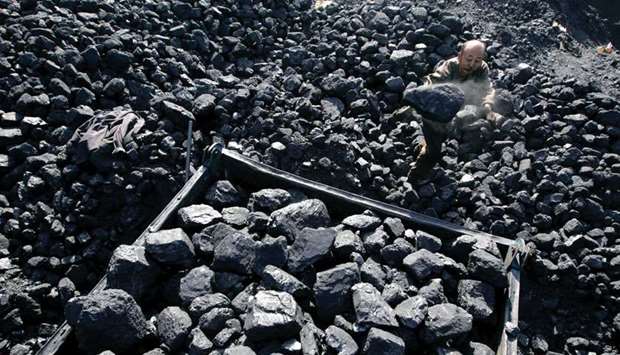Far from entering the death throes predicted by some environmentalists and analysts, thermal coal miners are enjoying their best returns in years as strong Asian demand and tight supplies send prices soaring.
Chinese thermal coal futures hit a record of 687 yuan ($108.49) this week, up five-fold from their 2016 lows.
Coal cargo prices from Australia’s Newcastle terminal, meanwhile, have roughly doubled since 2016 lows to over $100 per tonne, not far off 2011-2012 levels.
“The coal price improvement has thrown into stark relief the robustness of underlying demand in Asia,” Paul Flynn, chief executive of Australian miner Whitehaven Coal, said. “This had been masked until recent times by the surplus of capacity constructed during the last cycle. This period has now passed.”
While the spotlight of a broad energy market revival has been on oil and natural gas, specialist thermal coal miners are enjoying an even better run, suggesting investors think this much reviled fossil fuel has life in it still.
“We made global thermal coal our favourite commodity in October and stuck with it,” said Jeremy Sussman, New York-based analyst at brokerage and investment bank Clarksons Platou.
Whitehaven, Indonesia’s Adaro Energy and global commodity merchant Glencore have all seen their share prices multiply from record lows in 2015-2016, hitting levels last seen during the mining boom before 2012.
“We expect coal prices to remain meaningfully higher than expectations, and as such, believe Whitehaven can keep moving higher,” Sussman said.
The rise in coal prices has taken many by surprise.
Morningstar Equity Research said coal prices “have fared better than we expected due to continued strong growth in China”. As a result, Whitehaven has seen its share price soar since its early 2016 low.
Adaro and Glencore have enjoyed rallies of 330% and 290%, respectively.
Shares in Thai coal miner Banpu are up 85%. That compares to increases of 18% to 45% for competitors specialising in exporting liquefied natural gas (LNG), including Australia’s Woodside Petroleum and Santos or US firm Cheniere.
With many listed investors shunning coal due to concerns and pressure over its environmental impact, the profits of the coal boom are being enjoyed by others.
Whitehaven’s biggest shareholders are US-based Farallon Capital Management, which holds 14% of the stock, followed by specialist mining investor AMCI Group with 8.4%.
AMCI Group managing director Brian Beem said the outlook for high grade thermal coal and steelmaking coal was positive.
“The urbanisation and electrification of Asia will continue to drive demand for these commodities, and we see supply struggling to meet that demand because of depletion and lack of investment in new capacity,” Beem said in e-mailed comments.
Farallon Capital Management declined to comment.
Glencore, the world’s biggest single thermal coal exporting firm, said it could not comment for this article as it is in close period ahead of its annual results.
During an investor call in December, Glencore said it expects an average coal production unit cost of $48 per tonne in 2018, allowing it to comfortably generate cash at current prices.
General under-investment in the sector in past years was allowing the company to now reap the benefits of higher prices, Glencore added.
Indonesia’s Adaro declined to comment.
At the heart of the strong performance is the fact that, despite the rise of LNG and renewables, thermal coal consumption has barely dropped across Asia.
Trade data in Thomson Reuters Eikon showed shipments of thermal coal to north and south Asia’s main energy consumers, which make up half the world’s population and form the fastest growing block of energy consumers, have not dropped versus LNG since 2016.
In Japan, a top coal and LNG consumer, imports of thermal coal rose 4.3% last year to a record 114.5mn tonnes. LNG purchases rose 0.4% to 83.6mn tonnes.
South Korea’s coal imports rose by more than 10% in 2017.
China’s 2017 coal imports were at their highest level since 2014, at 270.9mn tonnes.
Indian coal imports have also started growing again after years of stagnation.
Globally, sea-borne coal trade increased by 1.5% between 2016 and 2017, to 1.143bn tonnes, according to coal industry group VDKI.
Asia’s share of global coal consumption has increased from less than 50% in 2000 to nearly 74% in 2016.
Whitehaven’s Flynn said strong power demand growth, in part thanks to the rise of electric vehicles, would push up demand further, including for thermal coal.
Despite coal’s stellar recent performance, doubts over its long-term outlook remain.
Many analysts say the future of power generation lies with cleaner technology such as gas, solar and wind.
In a massive effort to combat pollution, China is in the early stages of a huge gasification programme, moving industry and millions of households from coal to gas.
China’s natural gas imports and production are set to rise faster than its energy demand.
Given China is also investing large-scale into the spread of renewables and even nuclear power, its share of coal will fall. Morningstar for one believes that means the upside for mining stocks like Whitehaven “is nearly done.”

A worker loads coal onto a cart at a coal mine in Taiyuan, Shanxi province.


